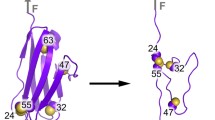Abstract
The intrinsic component of the standard free energy change for the formation of a disulfide bond in a protein molecule is compared to that for an analogous chemical reaction. The former reaction, which represents theintramolecular formation of a disulfide bond in a protein molecule from a cysteine group containing a mixed disulfide bond with glutathione, and a free cysteine residue, is a unimolecular reaction. In contrast, its chemical analogue is a bimolecular reaction, and corresponds to theintermolecular disulfide interchange between a mixed disulfide-bonded compound between a cysteine residue and glutathione, and a free cysteine molecule. The difference in the intrinsic free energy of the above two reactions is estimated by two different approaches. First, a theoretical estimate of the magnitude of the difference in free energy of the two reactions (for a standard state of 1 M) is obtained using a gas-phase statistical thermodynamic approach, which indicates that the intramolecular reaction is energetically favored over its intermolecular counterpart by as much as 15.6 kcal/mole. For comparison, an experimentally derived value is also obtained, using experimental data from a study by Konishi et al. of the regeneration of the protein ribonuclease A (RNase A) from its reduced form by reduced and oxidized glutathiones. The intrinsic component of the free energy change of the intramolecular reaction, as it occurs in the protein molecule, is obtained from such experimental data by accounting explicitly for the free energy change (assumed to be solely an entropy change) pertaining to the conformational changes (ring closure) that the protein molecule undergoes in the course of the reaction. On the basis of the value derived from such an experimental approach, the intramolecular reaction is also energetically more favorable as compared to its intermolecular analogue, but only by a difference of 2.3 kcal/mole (for a standard state of 1 M). The large apparent discrepancy between the two values estimated from the theoretical and experimental approaches is rationalized by the postulation of several additional factors not inherent in the gas-phase theoretical estimate, such as dehydration and intramolecular hydrogen-bonding effects, which can largely compensate for the otherwise favorable energetics of the intramolecular reaction.
Similar content being viewed by others
References
Anderson, W. L., and Wetlaufer, D. B. (1976).J. Biol. Chem. 251, 3147–3153.
Benford, G. A., and Wassermann, A. (1939).J. Chem. Soc. 1939, 367–371.
Brunner, H., Holz, M., and Jering, H. (1974).Eur. J. Biochem. 50, 129–133.
Chothia, C. (1976).J. Mol. Biol. 105, 1–14.
Creighton, T. E. (1977a).J. Mol. Biol. 113, 275–293.
Creighton, T. E. (1977b).J. Mol. Biol. 113, 295–312.
Creighton, T. E. (1977c).J. Mol. Biol. 113, 329–341.
Creighton, T. E. (1978).Prog. Biophys. Mol. Biol. 33, 231–297.
Creighton, T. E. (1979).J. Mol. Biol. 129, 411–431.
Creighton, T. E. (1980).FEBS Lett. 118, 283–288.
Creighton, T. E., and Goldenberg, D. P. (1984).J. Mol. Biol. 179, 497–526.
Creighton, T. E., Kalef, E., and Arnon, R. (1978).J. Mol. Biol. 123, 129–147.
Fersht, A. R., and Kirby, A. J. (1980).Chem. Br. 16, 136–142.
Flory, P. J. (1956).J. Am. Chem. Soc. 78, 5222–5235.
Galat, A., Creighton, T. E., Lord, R. C., and Blout, E. R. (1981).Biochemistry 20, 594–601.
Hantgan, R. R., Hammes, G. G., and Scheraga, H. A. (1974).Biochemistry 13, 3421–3431.
Janin, J. (1979).Nature 277, 491–492.
Jencks, W. P. (1975).Adv. Enzymol. 43, 219–410.
Jocelyn, P. C. (1967).Eur. J. Biochem. 2, 327–331.
Johnson, R. E., Adams, P., and Rupley, J. A. (1978).Biochemistry 17, 1479–1484.
Kauzmann, W. (1959).Adv. Protein Chem. 14, 1–63.
Klotz, I. M., and Franzen, J. S. (1962).J. Am. Chem. Soc. 84, 3461–3466.
Konishi, Y., and Scheraga, H. A. (1980a).Biochemistry 19, 1308–1316.
Konishi, Y., and Scheraga, H. A. (1980b).Biochemistry 19, 1316–1322.
Konishi, Y., Ooi, T., and Scheraga, H. A. (1981).Biochemistry 20, 3945–3955.
Konishi, Y., Ooi, T., and Scheraga, H. A. (1982a).Biochemistry 21, 4734–4740.
Konishi, Y., Ooi, T., and Scheraga, H. A. (1982b).Biochemistry 21, 4741–4748.
Konishi, Y., Ooi, T., and Scheraga, H. A. (1982c).Proc. Natl. Acad. Sci. USA 79, 5734–5738.
Kosen, P. A., Creighton, T. E., and Blout, E. R. (1980).Biochemistry 19, 4936–4944.
Kosen, P. A., Creighton, T. E., and Blout, E. R. (1981).Biochemistry 20, 5744–5754.
Kosen, P. A. Creighton, T. E., and Blout, E. R. (1983).Biochemistry 22, 2433–2440.
Laskowski, M., Jr., and Scheraga, H. A. (1954).J. Am. Chem. Soc. 76, 6305–6319.
Laskowski, M., Jr., and Scheraga, H. A. (1956).J. Am. Chem. Soc. 78, 5793–5798.
Laskowski, M., Jr., and Scheraga, H. A. (1961).J. Am. Chem. Soc. 83, 266–274.
Lin, S. H., Konishi, Y., Denton, M. E., and Scheraga, H. A. (1984).Biochemistry 23, 5504–5512.
Nozaki, Y., and Tanford, C. (1971).J. Biol. Chem. 246, 2211–2217.
Page, M. I. (1973).Chem. Soc. Rev. 2, 295–323.
Page, M. I., and Jencks, W. P. (1971).Proc. Natl. Acad. Sci. USA 68, 1678–1683.
Poland, D. C., and Scheraga, H. A. (1965).Biopolymers 3, 379–399.
Saxena, V. P., and Wetlaufer, D. B. (1970).Biochemistry 9, 5015–5022.
Scheraga, H. A., Konishi, Y., and Ooi, T. (1984).Adv. Biophys. 18, 21–41.
Snyder, G. H., Rowan, R., III, and Sykes, B. D. (1976).Biochemistry 15, 2275–2283.
States, D. J., Dobson, C. M., Karplus, M., and Creighton, T. E. (1980).Nature 286, 630–632.
Steinberg, I. Z., and Scheraga, H. A. (1963).J. Biol. Chem. 238, 172–181.
Tanford, C. (1970).Adv. Protein Chem. 24, 1–95.
Ueda, T., Yamada, H., Hirata, M., and Imoto, T. (1985).Biochemistry 24, 6316–6322.
Vincent, J.-P., Chicheportiche, R., and Lazdunski, M. (1971).Eur. J. Biochem. 23, 401–411.
Wagner, G., and Wüthrich, K. (1979).J. Mol. Biol. 130, 31–37.
Wagner, G., Tschesche, H., and Wüthrich, K. (1979a).Eur. J. Biochem. 95, 239–248.
Wagner, G., Kalb, A. J., and Wüthrich, K. (1979b).Eur. J. Biochem. 95, 249–253.
Wassermann, A. (1965).Diels-Alder Reactions, Elsevier, Amsterdam.
Westheimer, F. H. (1962).Adv. Enzymol. 24, 441–482.
Author information
Authors and Affiliations
Rights and permissions
About this article
Cite this article
Mui, P.W., Konishi, Y. & Scheraga, H.A. Comparison of intramolecular and intermolecular reactions in protein folding. J Protein Chem 5, 29–49 (1986). https://doi.org/10.1007/BF01025582
Received:
Published:
Issue Date:
DOI: https://doi.org/10.1007/BF01025582




